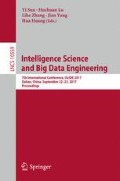Abstract
Age-related macular degeneration (AMD) is a common cause of vision loss among the elderly in developed countries. Geographic atrophy (GA) appears in advanced stages of non-exudative AMD. In this paper, we present a hybrid GA segmentation model for spectral-domain optical coherence tomography (SD-OCT) images. The method first segments the layered structure of the SD-OCT scan data and produces the projection images. Then we construct the histogram of the resulting image into a probability distribution function, and use this function to fit a Gaussian mixed model (GMM) by Moth-flame optimization (MFO) algorithm. To incorporate the globe spatial information to over come the impact of noise, a robust affinity diffusion method is proposed to construct the affinity map. Finally, bias field correction process is employed to remove the intensity inhomogeneity. Two data sets, respectively consisting on 55 SD-OCT scans from twelve eyes in eight patients with GA and 56 SD-OCT scans from 56 eyes in 56 patients with GA, are utilized to quantitatively evaluate the segmentation algorithm. Experimental results demonstrate that the proposed algorithm can achieve high segmentation accuracy.
Access this chapter
Tax calculation will be finalised at checkout
Purchases are for personal use only
References
Niu, S., De, S.L., Chen, Q., et al.: Automated geographic atrophy segmentation for SD-OCT images using region-based C-V model via local similarity factor. Biomed. Opt. Express 7(2), 581 (2016)
Wang, J.J., Rochtchina, E., Lee, A.J., et al.: Ten-year incidence and progression of age-related maculopathy: the Blue Mountains Eye Study. Ophthalmology 114(1), 92–98 (2007)
Klein, R., Klein, B.E.K., Knudtson, M.D., et al.: Fifteen-year cumulative incidence of age-related macular degeneration: the Beaver Dam Eye Study. Ophthalmology 114(2), 253–262 (2007)
Buch, H., Nielsen, N.V., Vinding, T., et al.: 14-year incidence, progression, and visual morbidity of age-related maculopathy: the Copenhagen City Eye Study. Ophthalmology 112(5), 787–798 (2005)
Bindewald, A., Bird, A.C., Dandekar, S.S., et al.: Classification of fundus autofluorescence patterns in early age-related macular disease. Invest. Ophthalmol. Vis. Sci. 46(9), 3309–3314 (2005)
Schmitz-Valckenberg, S., Brinkmann, C.K., Alten, F., et al.: Semiautomated image processing method for identification and quantification of geographic atrophy in age-related macular degeneration. Invest. Ophthalmol. Vis. Sci. 52(10), 7640–7646 (2011)
Deckert, A., Schmitz-Valckenberg, S., Jorzik, J., et al.: Automated analysis of digital fundus autofluorescence images of geographic atrophy in advanced age-related macular degeneration using confocal scanning laser ophthalmoscopy (cSLO). BMC Ophthalmol. 5(1), 8 (2005)
Lee, N., Laine, A., Barbazetto, I., et al.: Level set segmentation of geographic atrophy in macular autofluorescence images. Invest. Ophthalmol. Vis. Sci. 47(13), 2125 (2006)
Allingham, M.J., Nie, Q., Lad, E.M., et al.: Semiautomatic segmentation of rim area focal hyperautofluorescence predicts progression of geographic atrophy due to dry age-related macular degeneration. Invest. Ophthalmol. Vis. Sci. 57(4), 2283–2289 (2016)
Hu, Z., Medioni, G.G., Hernandez, M., et al.: Automated segmentation of geographic atrophy in fundus autofluorescence images using supervised pixel classification. J. Med. Imaging 2(1), 014501 (2015)
Ramsey, D.J., Sunness, J.S., Malviya, P., et al.: Automated image alignment and segmentation to follow progression of geographic atrophy in age-related macular degeneration. Retina 34(7), 1296–1307 (2014)
Jeong, Y.J., Hong, I.H., Chung, J.K., et al.: Predictors for the progression of geographic atrophy in patients with age-related macular degeneration: fundus autofluorescence study with modified fundus camera. Eye 28(2), 209–218 (2014)
Yehoshua, Z., Rosenfeld, P.J., Gregori, G., et al.: Progression of geographic atrophy in age-related macular degeneration imaged with spectral domain optical coherence tomography. Ophthalmology 118(4), 679–686 (2011)
Chen, Q., De, S.L., Leng, T., et al.: Semi-automatic geographic atrophy segmentation for SD-OCT images. Biomed. Opt. Express 4(12), 2729–2750 (2013)
Tohka, J., Krestyannikov, E., Dinov, I., et al.: Genetic algorithms for finite mixture model based tissue classification in brain MRI. In: IFMBE Proceedings of European Medical and Biological Engineering Conference (EMBEC), pp. 4077–4082 (2005, 2013)
Mirjalili, S.: Moth-flame optimization algorithm: a novel nature-inspired heuristic paradigm. Knowl.-Based Syst. 89, 228–249 (2015)
Shi, J., Malik, J.: Normalized cuts and image segmentation. IEEE Trans. Pattern Anal. Mach. Intell. 22(8), 888–905 (2000)
Li, C., Gore, J.C., Davatzikos, C.: Multiplicative intrinsic component optimization (MICO) for MRI bias field estimation and tissue segmentation. Magn. Reson. Imaging 32(7), 913–923 (2014)
Wang, B., Tu, Z.: Affinity learning via self-diffusion for image segmentation and clustering. In: 2012 IEEE Conference on Computer Vision and Pattern Recognition (CVPR), pp. 2312–2319. IEEE (2012)
Jiao, S., Knighton, R., Huang, X., et al.: Simultaneous acquisition of sectional and fundus ophthalmic images with spectral-domain optical coherence tomography. Opt. Express 13(2), 444–452 (2005)
Acknowledgments
This work was supported in part by the National Natural Science Foundation of China under Grants 61401209 & 61671242, in part by the Natural Science Foundation of Jiangsu Province, China under Grant BK20140790, in part by the Fundamental Research Funds for the Central Universities under Grant 30916011324, and in part by China Postdoctoral Science Foundation under Grants 2014T70525 & 2013M531364.
Author information
Authors and Affiliations
Corresponding author
Editor information
Editors and Affiliations
Rights and permissions
Copyright information
© 2017 Springer International Publishing AG
About this paper
Cite this paper
Huang, Y., Ji, Z., Chen, Q., Niu, S. (2017). Geographic Atrophy Segmentation for SD-OCT Images by MFO Algorithm and Affinity Diffusion. In: Sun, Y., Lu, H., Zhang, L., Yang, J., Huang, H. (eds) Intelligence Science and Big Data Engineering. IScIDE 2017. Lecture Notes in Computer Science(), vol 10559. Springer, Cham. https://doi.org/10.1007/978-3-319-67777-4_42
Download citation
DOI: https://doi.org/10.1007/978-3-319-67777-4_42
Published:
Publisher Name: Springer, Cham
Print ISBN: 978-3-319-67776-7
Online ISBN: 978-3-319-67777-4
eBook Packages: Computer ScienceComputer Science (R0)

